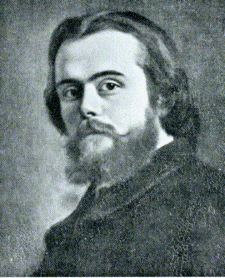Léon Walras
Marie-Esprit-Léon Walras (December 16, 1834 in Évreux, France - January 5, 1910 in Clarens, near Montreux, Switzerland) was a French economist, considered by Joseph Schumpeter as "the greatest of all economists". He was a mathematical economist associated with the creation of the general equilibrium theory.
Son of French economist Auguste Walras. Auguste was a school administrator and not a professional economist yet his economic thinking had a profound effect on his son. He found the value of goods by setting their scarcity relative to human wants.
Walras also inherited the role of social reformer from his father. Much like the Fabians, Walras called for the nationalization of land believing that land’s value would always increase and that rents from that land would be sufficient to support the nation without taxes.
Augustin Cournot, a schoolmate of Auguste was another of Walras’ influences. It was from Cournot that Walras inherited the tradition of French Rationalism as well as the use of mathematics in economics. Cournot created functional relationships where “quantities are related to demand prices and costs.” He also created the downward sloping demand curve.
One of the three leaders of the marginalist revolution, Walras was not familiar with the marginalist ideas of William Stanley Jevons or Carl Menger and developed his theories independently.
In 1874 and 1877 Walras published Elements of Pure Economics, a work that led him to be considered the father of the general equilibrium theory. The problem that Walras set out to solve was one presented by Cournot, that even though it could be demonstrated how individual markets behaved, it was still unknown how goods interacted with each other to effect supplies and demands.
Walras created a system of simultaneous equations in an attempt to solve Cournot’s problem. He recognized that while his system may be correct, the number of unknowns combined with the lack of information made it unsolvable.
To find equilibrium Walras set up a series of experiments called tâtonnement, or groping. Walras simulated groping by calling out prices and people responding how much they would supply or demand at that price, the price was adjusted until equilibrium was reached.
Professor at the University of Lausanne, Switzerland, Walras is credited for having founded what subsequently became known, under direction of his Italian disciple, the economist and sociologist Vilfredo Pareto, as the Lausanne school of economics.
Walras' Law
Walras' Law is a principle in general equilibrium theory that states that if markets for all but one good are in equilibrium, then all markets must be in equilibrium and the economy is in general equilibrium.
First, we define equilibrium for a good to be the situation in which the price of the good is such that the supply of the good is equal to the demand of the good. To illustrate, if Farmer Bing has one hundred cherries, and at $0.15 a cherry he wants to sell 50 cherries and keep the rest, then $0.15 is an equilibrium price if the total number of cherries that all his neighbors are willing to buy at $0.15 is exactly 50.
Now, for more complicated economies where there is more than one good on the market, we define general equilibrium to be the situation in which all the prices are such that each good is in equilibrium. It is also important to remember that, even though most of the time people want an unlimited amount of anything, when talking about equilibrium we are talking about a situation in which no one would be willing to pay any more money (i.e., no one would want to give up more of another good) to get more of the good in question. Walras' law states that if all but one good is in equilibrium, then all the goods are in equilibrium and the economy is in general equilibrium.
The idea behind it is that at any time that one person wants more of one good, she must be willing to sell some of another good in order to get it. If this occurs, then it is two goods, not simply one, which are not in equilibrium.
P'X(P)=0 P>=0 Where P is a price X is an amount vector in an economy with general equilibrium.
Walras' law says that there cannot be a one-sided disequilibrium in markets. For example, if the labour market is not in equilibrium because there is excess supply or in other words, unemployment, then there has to be a disequilibrium elswhere that matches it, like excess demand in the goods market. In other words, total excess demand and supply across all markets balance each other out.
This is somewhat contrary to the Keynesian thinking that the labour market can be in disequilibrium in a general equilibrium model.
External links
Credits
New World Encyclopedia writers and editors rewrote and completed the Wikipedia article in accordance with New World Encyclopedia standards. This article abides by terms of the Creative Commons CC-by-sa 3.0 License (CC-by-sa), which may be used and disseminated with proper attribution. Credit is due under the terms of this license that can reference both the New World Encyclopedia contributors and the selfless volunteer contributors of the Wikimedia Foundation. To cite this article click here for a list of acceptable citing formats.The history of earlier contributions by wikipedians is accessible to researchers here:
The history of this article since it was imported to New World Encyclopedia:
Note: Some restrictions may apply to use of individual images which are separately licensed.
